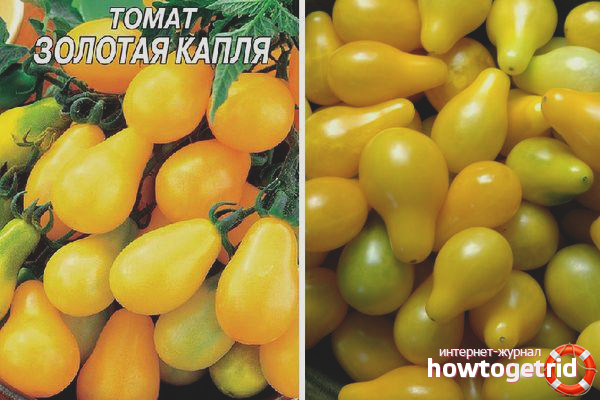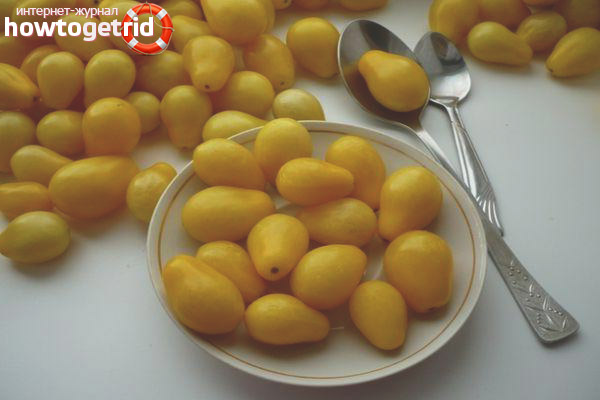The content of the article
Gardeners who appreciate attractive small-fruited tomatoes will no doubt like the Golden Drop. This is a new Russian tomato variety. Small fruits are distinguished by a very elegant pear-shaped shape. They can be used in the preparation of pickles and marinades, and with them, assorted vegetables are excellent. In this article we will consider all the main characteristics of the Golden Drop, its winning qualities and disadvantages.
Overview of Key Features
This tomato is of indeterminate type, and its plants are stretched to 190 centimeters. The bush is branched, slightly leafy; inflorescences of an intermediate type, the root system is usually well developed. The leaves of Golden drops are large, dark green in color.
The mid-season variety can boast of high yields - one square meter of plantation can produce a maximum of 5 kilograms of fruit. Tomatoes of this variety ripen throughout the season, its fruits can be picked separately, and whole brushes can be removed. On one bush grows up to 12 brushes.
Tomatoes of this variety are small in size, with smooth skin, and are oval-pear-shaped. Their weight can be within the range of 25 - 40 g. Ripened fruits have a honey-yellow, bright color. The peel is thin, but of sufficient density, which prevents them from cracking.
The Golden Drop is distinguished by its dense and juicy flesh with numerous seed chambers. The fruit tastes very pleasant, with an admixture of fruit tones. In the chemical composition, sugar reaches 3.8%, dry matter - 6%.
Information on the selection and use of tomatoes of this variety
Vegetables can be successfully used for making pickles and pickles, and with them excellent vegetable assortments are obtained. When canned, they retain their original shape; cracks do not appear on them. The elegant look of these tomatoes makes them indispensable for decorating dishes.
Winning qualities and disadvantages
The obvious advantages of the "Golden Drop" include:
- very pleasant taste of the fruit;
- unusual shape and their beautiful color;
- ability to bring a high yield;
- non-susceptibility to underlying diseases.
Some gardeners may consider it a drawback that in the tomatoes of this indeterminate variety it is necessary to form a bush. Also, these plants require garter because of their height.
Growing
- As for other mid-season varieties, the seeds of the "Golden Drop" are first germinated for seedlings. Sown closer to the end of March. It is recommended to use growth stimulants or freshly squeezed aloe juice for their processing.
- For soil under seedlings, turf and garden soil and humus are mixed. Then it is placed in a container or peat cup and sown seeds in them, deepening them minimally. Then the sown soil should be moistened, covered with a film and left in a warm place.When the primary sprouts hatch, the containers should be moved to where they will be well lit.
- When the first true leaves are formed on the stems, it is time to dive and feed the plants, for which mineral fertilizers are well suited.
- As soon as the seedlings are 55-60 days, you can begin preparations for its planting in the garden. To do this, loosen the soil in the greenhouse and make humus.
- Seedlings are planted with an interval of 50 cm and tied to supports. When the fruit ripens, heavy branches of the bush will also need a garter.
- For top dressing, a full mineral complex is introduced 3-4 times into the soil during the season. You can also fertilize with diluted mullein.
Exposure to Diseases and Pests
To maintain low humidity in the greenhouse, it is recommended to ventilate it after watering. So that tomatoes are not affected by gray, top or root rot, phytosporin or a pale pink solution of potassium permanganate is used for spraying. To protect young plants from insects, agronomists recommend the use of insecticides. You can also treat them with a decoction of celandine (it is allowed to use onion peel). In this way, thrips, whiteflies and spider mites are destroyed. To combat slugs, diluted ammonia is used, and with aphids - a warm soapy solution.
Tomatoes "Golden Drop" will be the decoration of any greenhouse. This variety is characterized by high productivity and is very unpretentious in cultivation. Suitable for industrial and individual production. Its fruits are very beautiful, tasty and healthy.
Video: Tomato Care - The First Important Steps!











Submit